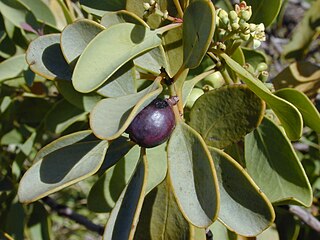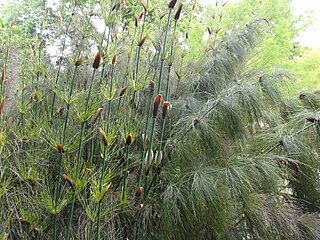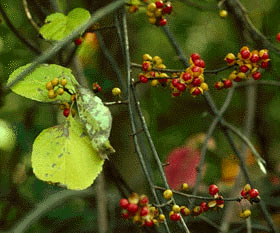
The Lamiaceae or Labiatae are a family of flowering plants commonly known as the mint, deadnettle, or sage family. Many of the plants are aromatic in all parts and include widely used culinary herbs like basil, mint, rosemary, sage, savory, marjoram, oregano, hyssop, thyme, lavender, and perilla, as well as other medicinal herbs such as catnip, salvia, bee balm, wild dagga, and oriental motherwort.

The Santalaceae, sandalwoods, are a widely distributed family of flowering plants which, like other members of Santalales, are partially parasitic on other plants. Its flowers are bisexual or, by abortion, unisexual. Modern treatments of the Santalaceae include the family Viscaceae (mistletoes), previously considered distinct.

The Cyperaceae are a family of graminoid (grass-like), monocotyledonous flowering plants known as sedges. The family is large; botanists have described some 5,500 known species in about 90 genera – the largest being the "true sedges", with over 2,000 species.

The Asclepiadoideae are a subfamily of plants in the family Apocynaceae. Formerly, it was treated as a separate family under the name Asclepiadaceae, e.g. by APG II, and known as the milkweed family.

The Restionaceae, also called restiads and restios, are a family of flowering plants native to the Southern Hemisphere; they vary from a few centimeters to 3 meters in height. Following the APG IV (2016): the family now includes the former families Anarthriaceae, Centrolepidaceae and Lyginiaceae, and as such includes 51 genera with 572 known species. Based on evidence from fossil pollen, the Restionaceae likely originated more than 65 million years ago during the Late Cretaceous period, when the southern continents were still part of Gondwana.

The Celastraceae are a family of 98 genera and 1,350 species of herbs, vines, shrubs and small trees, belonging to the order Celastrales. The great majority of the genera are tropical, with only Celastrus, Euonymus and Maytenus widespread in temperate climates, and Parnassia (bog-stars) found in alpine and arctic climates.

Knightia is a small genus of the family Proteaceae endemic to New Zealand, named in honor of Thomas Andrew Knight. One extant species, K. excelsa (rewarewa) is found in New Zealand. Two further Knightia species are found in New Caledonia, although they were placed in the genus Eucarpha by Lawrie Johnson and Barbara Briggs in their influential 1975 monograph "On the Proteaceae: the evolution and classification of a southern family", a placement supported in a 2006 classification of the Proteaceae. A fossil species from upper Miocene deposits in Kaikorai has been described as Knightia oblonga. Knightia has been placed in the tribe Roupaleae of the subfamily Grevilleoideae.

Leucopogon is a genus of about 150-160 species of shrubs or small trees in the family Ericaceae, in the section of that family formerly treated as the separate family Epacridaceae. They are native to Australia, New Zealand, New Caledonia, the western Pacific Islands and Malaysia, with the greatest species diversity in the south-west of Western Australia. Plants in this genus have leaves with a few more or less parallel veins, and tube-shaped flowers usually with a white beard inside.

Myoporum is a genus of flowering plants in the figwort family, Scrophulariaceae. There are 30 species in the genus, eighteen of which are endemic to Australia although others are endemic to Pacific Islands, including New Zealand, and one is endemic to two Indian Ocean islands. They are shrubs or small trees with leaves that are arranged alternately and have white, occasionally pink flowers and a fruit that is a drupe.

Persoonia, commonly known as geebungs or snottygobbles, is a genus of about one hundred species of flowering plants in the family Proteaceae. Plants in the genus Persoonia are shrubs or small trees usually with smooth bark, simple leaves and usually yellow flowers arranged along a raceme, each flower with a leaf or scale leaf at the base. The fruit is a drupe.

Sterculia is a genus of flowering plants in the mallow family, Malvaceae: subfamily Sterculioideae. Members of the genus are colloquially known as tropical chestnuts. Sterculia may be monoecious or dioecious, and its flowers unisexual or bisexual.

Pittosporaceae is a family of flowering plants that consists of 200–240 species of trees, shrubs, and lianas in 9 genera. Habitats range from tropical to temperate climates of the Afrotropical, Indomalayan, Oceanian, and Australasian realms. The type genus is Pittosporum Banks ex Gaertn.

Escalloniaceae is a family of flowering plants consisting of about 130 species in eight genera. In the APG II system it is one of eight families in the euasterids II clade (campanulids) that are unplaced as to order. More recent research has provided evidence that two of those families, Eremosynaceae and Tribelaceae, arose from within Escalloniaceae; the Angiosperm Phylogeny Website therefore merges these two families into Escalloniaceae, and also places the family alone in order Escalloniales.

Petrophile is a genus of evergreen shrubs, in the family Proteaceae. The genus is endemic to Australia. Commonly known as conebushes, they typically have prickly, divided foliage and produce prominently-displayed pink, yellow or cream flowers followed by grey, conical fruits.

Serruria, or spiderhead is a genus of flowering plants in the family Proteaceae, endemic to South Africa.

Lumnitzera is an Indo-West Pacific mangrove genus in the family Combretaceae. An English common name is black mangrove. Lumnitzera, named after the German botanist, Stephan Lumnitzer (1750-1806), occurs in mangroves from East Africa to the Western Pacific, and northern Australia.
Eucarpha is a genus of flowering plant of the family Proteaceae, endemic to New Caledonia. Two species are recognised. Up to 1975, these were classified within the genus Knightia until Lawrence Johnson and Barbara G. Briggs recognised their distinctness, particularly their prominent bracts, in their 1975 monograph "On the Proteaceae: the evolution and classification of a southern family". Nomenclatural combinations for these two species in the genus Eucarpha were published in 2022.

Zanthoxyloideae is a subfamily of the family Rutaceae. Its most notable member is probably Sichuan pepper.

















